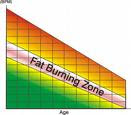Well, it’s about time I do some talking about the Calories Out side of the body weight equation – and that is exercise.
I am often asked about what intensity of exercise is the most effective for weight loss. At the gym or on your home workout machine, you may have noted that the medium range of exertion is labelled as the ‘fat burning zone’, and the intense range of exercise is labelled as the ‘carb burning zone’. Based on this, many people conclude that they will lose weight (fat) faster if they exercise at moderate intensity, than if they work out at a higher intensity.
True or False?
The short answer: False!
The long answer:
Your rate of weight loss, or weight gain, is based simply on the difference between your Calories In (what you eat) and your Calories Out (what you expend). So, if you exercise at a higher intensity for a fixed period of time (let’s say, cycling hard for 30 minutes), you will burn more calories than if you do the same activity for the same period of time, but at a moderate intensity (cycling at a medium intensity for 30 minutes).
So what is this ‘fat burning zone’ all about? Well, it is true that when you exercise at moderate intensity, your metabolism is in a zone where it will choose primarily fat as its fuel source, whereas when you are in the high intensity zone, your body is choosing carbohydrate as its primary energy source. The key point, however, is that the body is exceptionally talented at moving energy stores around between fat, carbohydrate and protein. Thus, when all is said and done, the body will balance out these energy stores again, such that it is prepared for the next period where you demand of it again. So while you burn proportionally more fat (relative to carbohydrate) at medium intensity, the overall calories burnt is lower, and once your body finishes redistributing your energy stores, you end up with more energy (including fat) left in your body than if you had exercised at a high intensity. At the high intensity, on the other hand, your body would have burned proportionally more carbs (relative to fat), but after re-equilibrating, your body would have had to draw on some fat stores to replenish the carb stores, and with less calories overall in your body, you will also have less fat! (It is a bit more complicated than that, but this is the jist of it.)
Repeated over time, the difference between moderate and high intensity workouts adds up! If you burn an extra 100 calories per day (which can be very reasonably accomplished by turning up a moderate 30 minute workout into an intense one), you will lose 10 pounds in a year. This, of course, assumes that you have recognized and avoided the #1 PITFALL of high intensity workouts to the person trying to lose weight – and that is that high intensity workouts can make you HUNGRY!! An appetite just as intense as the workout you just had can result in overconsumption of calories, to the point where you have lost the benefit of the intense workout, and perhaps eaten yourself into bringing more Calories In than what you put out! One third of a Snickers bar can wipe out that 100 calorie extra burn that you got from your workout.
If you decide to step up your workouts, make sure you speak with your doctor first, particularly if you have any medical conditions. It is also advisable to ramp up your workouts gradually rather than just jumping into hard core workouts – this is safest from a cardiovascular perspective, and also helps to avoid injury.
Dr. Sue © 2009 www.drsue.ca drsuetalks@gmail.com











